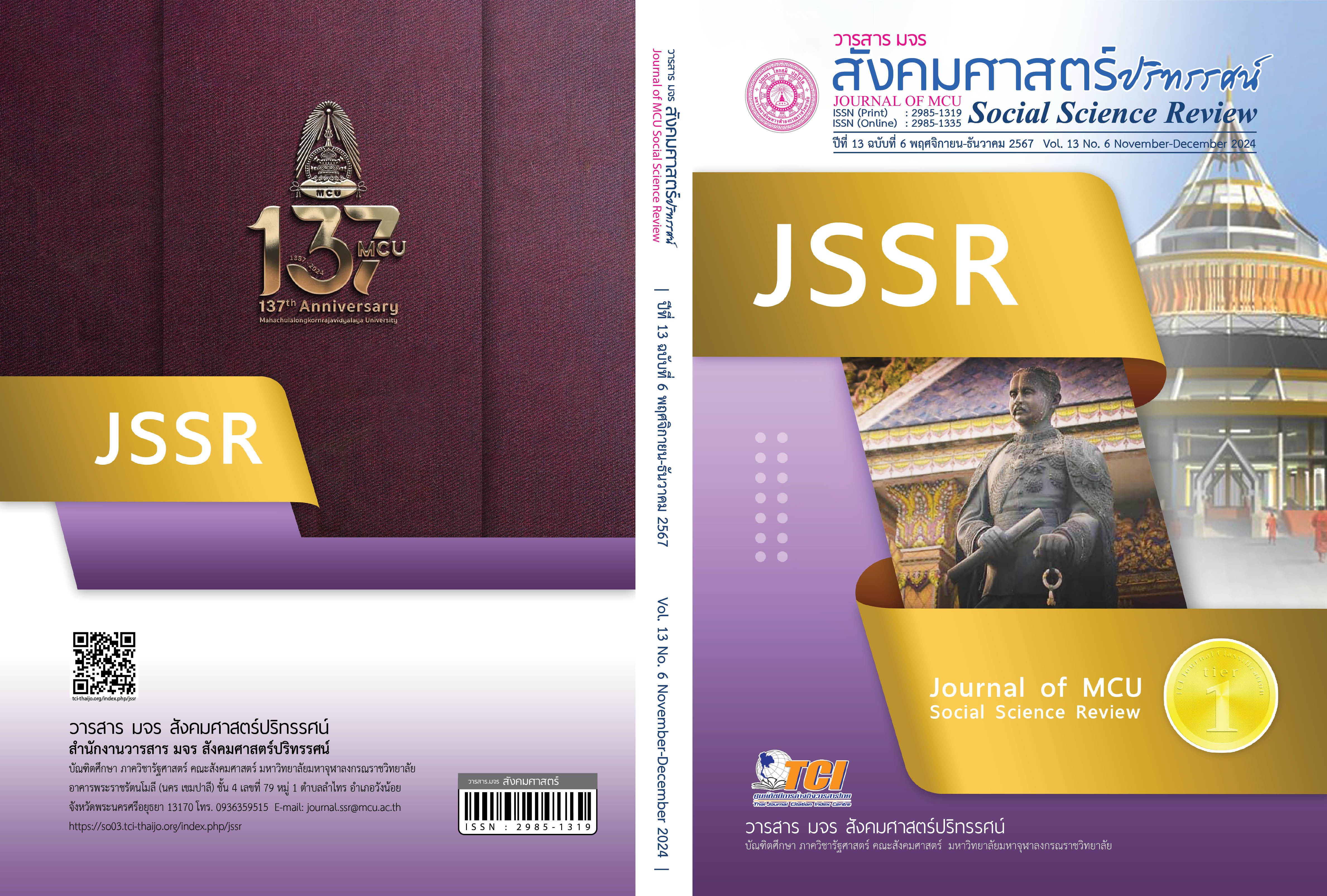การพัฒนาความสามารถด้านการอ่านอย่างมีวิจารณญาณ และการคิดแก้ปัญหาเชิงสร้างสรรค์ของนักเรียนชั้นมัธยมศึกษาปีที่ 3 ด้วยการจัดกิจกรรม การเรียนรู้โดยใช้ปัญหาเป็นฐาน
คำสำคัญ:
การจัดกิจกรรมการเรียนรู้โดยใช้ปัญหาเป็นฐาน, การอ่านอย่างมีวิจารณญาณ, การแก้ปัญหาเชิงสร้างสรรค์บทคัดย่อ
บทความวิจัยนี้มีวัตถุประสงค์ 1. พัฒนาความสามารถด้านการอ่านอย่างมีวิจารณญาณ และ 2. พัฒนาความสามารถการคิดแก้ปัญหาเชิงสร้างสรรค์ของนักเรียนมัธยมศึกษาปีที่ 3 ด้วยการจัดกิจกรรมการเรียนรู้โดยใช้ปัญหาเป็นฐาน โดยมีคะแนนผ่านเกณฑ์ ร้อยละ 80 กลุ่มตัวอย่างที่ใช้ในการวิจัยครั้งนี้ คือ นักเรียนชั้นมัธยมศึกษาปีที่ 3 จำนวน 33 คน ได้มาจากการสุ่มอย่างง่าย 1 ห้องเรียน โรงเรียนบ้านเหลื่อมพิทยาสรรพ์ สังกัดเขตพื้นที่การศึกษามัธยมศึกษานครราชสีมา ภาคเรียนที่ 1 ปีการศึกษา 2566 แบบแผนการวิจัยครั้งนี้เป็นแบบ One -Group ใช้การวิจัยเชิงปฏิบัติการในห้องเรียนตามแนวคิดของ Kemmis & Mc Taggart ประกอบด้วย 4 ขั้นตอน คือ 1. ขั้นวางแผน 2. ขั้นปฏิบัติการ 3. ขั้นสังเกตการณ์ 4. ขั้นสะท้อนผลการปฏิบัติ จัดกิจกรรมการเรียนรู้แบบ PBL ใช้เครื่องมือในการทดลองปฏิบัติการด้วยแผนการจัดการเรียนรู้ จำนวน 3 วงจร ๆ ละ 4 แผนรวม ทั้งสิ้น 12 แผนละ 50 นาที และเครื่องมือที่ใช้ในการประเมินผลการวิจัยประกอบด้วย 1. แบบทดสอบวัดความสามารถด้านการอ่านอย่างมีวิจารณญาณ และ 2. แบบทดสอบวัดความสามารถการคิดแก้ไขปัญหาเชิงสร้างสรรค์ วิเคราะห์ข้อมูลเชิงปริมาณด้วยสถิติ ค่าเฉลี่ยเลขคณิต ส่วนเบี่ยงเบนมาตรฐานและร้อย และการวิเคราะห์ข้อมูลเชิงคุณภาพใช้การวิเคราะห์เชิงเนื้อหา
ผลการวิจัยพบว่า 1. นักเรียนมีค่าเฉลี่ยของคะแนนความสามารถด้านการอ่านอย่างมีวิจารณญาณ 25.48 คิดเป็นร้อยละ 84.95 และค่าส่วนเบี่ยงเบนมาตรฐานคือ 1.60 นักเรียนที่ผ่านเกณฑ์มีจำนวน 29 คนคิดเป็นร้อยละ 87.87 2. นักเรียนมีค่าเฉลี่ยของคะแนนความสามารถด้านการคิดแก้ปัญหาเชิงสร้างสรรค์ 24.61 คิดเป็นร้อยละ 82.02 และค่าส่วนเบี่ยงเบนมาตรฐาน 0.97 นักเรียนที่มีคะแนนผ่านเกณฑ์จำนวน 30 คนคิดเป็นร้อยละ 90.90
เอกสารอ้างอิง
กระทรวงศึกษาธิการ. (2551). แนวทางการพัฒนา การวัดและประเมินคุณลักษณะอันพึงประสงค์ ตามหลักสูตรแกนกลางการศึกษาขั้นพื้นฐาน พุทธศักราช 2551. กรุงเทพฯ: สำนักวิชาการและมาตรฐานการศึกษา สำนักงานคณะกรรมการการศึกษาขั้นพื้นฐาน.
จิรวัฒน์ เพชรรัตน์ และอัมพร ทองใบ. (2556). การอ่านเพื่อพัฒนาคุณภาพชีวิต. กรุงเทพฯ: โอเดียนสโตร์.
ณชานันท์ ประเสริฐสุข. (2559). การพัฒนาการจัดการเรียนรู้โดยใช้ปัญหาเป็นฐาน เพื่อส่งเสริมการคิดอย่างมีวิจารณญาณ สำหรับนักเรียนชั้นมัธยมศึกษาตอนปลาย (การค้นคว้าอิสระการศึกษามหาบัณฑิต). พิษณุโลก: มหาวิทยาลัยนเรศวร.
ทิศนา แขมมณี. (2546). รูปแบบการเรียนการสอน : ทางเลือกที่หลากหลาย. กรุงเทพฯ: สำนักพิมพ์แห่งจุฬาลงกรณ์มหาวิทยาลัย.
ประจักษ์ น้อยเหนื่อย และมาเรียม นิลพันธุ์. (2564). การขยายผลรูปแบบการจัดการเรียนรู้วรรณคดีไทยตามแนวคิด Active Learning เพื่อส่งเสริมความสามารถในการแก้ปัญหาเชิงสร้างสรรค์และความซาบซึ้งในวรรณคดีไทยของนักเรียนระดับชั้นมัธยมศึกษาตอนปลาย. Academic MCU Buriram Journal, 6(2), 128-143.
พันธุ์ทิพย์ เกื้อเพชรแก้ว. (2545). ปัญหาการสอนอ่านย่อความในระดับอุดมศึกษา. วิชาการ, 5(6), 51-58.
วิจารณ์ พานิช. (2558). การเรียนรู้สู่การเปลี่ยนแปลง. กรุงเทพฯ: บริษัท เอส.อาร์.พริ้นติ้งแมสโปรดักส์ จํากัด.
สำนักงานเลขาธิการสภาการศึกษา. (2550). การจัดการเรียนรู้แบบบูรณาการสู่พหุปัญญา. กรุงเทพฯ: ชุมนุมสหกรณ์ การเกษตรแห่งประเทศไทย.
สำนักงานเลขาธิการสภาการศึกษา. (2550). รูปแบบการจัดการเรียนรู้เพื่อพัฒนาความสามารถของเด็กในการอ่านคิดวิเคราะห์เขียนและสร้างองค์ความรู้ด้วยตนเองโดยเน้นผู้เรียนเป็นสำคัญ. กรุงเทพฯ: สำนักงานเลขาธิการสภาการศึกษา.
สำนักวิชาการและมาตรฐานการศึกษา. (2553). ชุดฝึกอบรมการวัดและประเมินผลการเรียนรู้หลักสูตรแกนกลางการศึกษาขั้นพื้นฐาน พุทธศักราช 2551. กรุงเทพฯ: โรงพิมพ์ชุมชนสหกรณ์การเกษตรแห่งประเทศไทย.
สุคนธ์ สินธพานนท์ และคณะ. (2552). นวัตกรรมการเรียนการสอนเพื่อพัฒนาคุณภาพของเยาวชน (พิมพ์ครั้งที่ 3). กรุงเทพฯ: 9119 เทคนิคพริ้นติ้ง.
เอมอร เนียมน้อย. (2551). การพัฒนาการอ่านอย่างมีวิจารณญาณด้วยวิธี SQ3R. กรุงเทพฯ: สุวีริยาสาส์น.
Kemmis, S. & McTaggart, R. (1992). The action research planner (3rd ed.). Australia: Deakin University.
Kowalski, R. & Westen, D. (2009). Psychology (5th ed.). Denvers: John Wiley & Sons.
ดาวน์โหลด
เผยแพร่แล้ว
รูปแบบการอ้างอิง
ฉบับ
ประเภทบทความ
สัญญาอนุญาต
ลิขสิทธิ์ (c) 2024 วารสาร มจร สังคมศาสตร์ปริทรรศน์

อนุญาตภายใต้เงื่อนไข Creative Commons Attribution-NonCommercial-NoDerivatives 4.0 International License.
เพื่อให้เป็นไปตามกฎหมายลิขสิทธิ์ ผู้นิพนธ์ทุกท่านต้องลงลายมือชื่อในแบบฟอร์มใบมอบลิขสิทธิ์บทความให้แก่วารสารฯ พร้อมกับบทความต้นฉบับที่ได้แก้ไขครั้งสุดท้าย นอกจากนี้ ผู้นิพนธ์ทุกท่านต้องยืนยันว่าบทความต้นฉบับที่ส่งมาตีพิมพ์นั้น ได้ส่งมาตีพิมพ์เฉพาะในวารสาร มจร สังคมศาสตร์ปริทรรศน์ เพียงแห่งเดียวเท่านั้น หากมีการใช้ภาพหรือตารางหรือเนื้อหาอื่นๆ ของผู้นิพนธ์อื่นที่ปรากฏในสิ่งตีพิมพ์อื่นมาแล้ว ผู้นิพนธ์ต้องขออนุญาตเจ้าของลิขสิทธิ์ก่อน พร้อมทั้งแสดงหนังสือที่ได้รับการยินยอมต่อบรรณาธิการ ก่อนที่บทความจะได้รับการตีพิมพ์ หากไม่เป็นไปตามข้อกำหนดเบื้องต้น ทางวารสารจะถอดบทความของท่านออกโดยไม่มีข้อยกเว้นใดๆ ทั้งสิ้น





